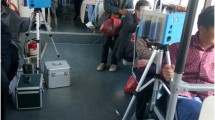Abstract
Ventilation system in a bus is employed to provide good indoor air quality and thermal comfort for passengers. Poor ventilation system will increase the concentration level of air contaminants which could affect the passenger’s health. The presence mixing ventilation system used in many buses is not efficient in removing the air contaminants from the passenger compartments. This article presents a study on the effects of using different ventilation setups on the concentration level of gases and particulate matters inside a passenger compartment of a university’s shuttle bus. The goal is to find a suitable layout of the air supply diffusers and air return grilles that would lower the concentration level of contaminants inside the passenger compartment. Field measurements were carried out to quantify the concentration of gases (carbon monoxide, carbon dioxide and formaldehyde) and particulate matters (PM1, PM2.5 and PM10). The measurements were done at the front section of the bus compartment, close to the front door. The data were acquired in the morning, afternoon and evening hours during a clear and sunny day. The bus travelled along an in-campus road with no passengers. A simplified three-dimensional model of the bus compartment was developed using computational fluid dynamics software. Flow analyses were carried out to predict distribution of gases and particulate matters concentration. The concentrations of carbon dioxide, carbon monoxide, formaldehyde and particulate matters obtained from the field measurements were used as boundary conditions and for validating the computational model. A parametric study was carried out to identify a suitable layout of air supply diffusers and air return grilles that would lower the concentration level of the air contaminants. Two types of ventilation systems were considered namely a displacement ventilation and an underfloor air distribution. Results show that the underfloor air distribution system is more effective in reducing the concentration level of gases and particulate matters inside the passenger compartment compared to the displacement ventilation system.
Similar content being viewed by others
References
Akbari, K. and Mahmoudi, J. (2012). Numerical simulation of radon transport and indoor air conditions effects. Int. J. Scientific and Engineering Research 3, 6, 1–9.
Ashrae Standard Committee (2013). Ashrae Handbook: Fundamentals. Ashrae.
Chan, M. Y. (2005). Commuters’ exposure to carbon monoxide and carbon dioxide in air-conditioned buses in Hong Kong. Indoor and Built Environment 14, 5, 397–403.
Chan, L. Y., Lau, W. L., Lee, S. C. and Chan, C. Y. (2002). Commuter exposure to particulate matter in public transportation modes in Hong Kong. Atmospheric Environment 36, 21, 3363–3373.
Cheong, K. W. D. and Phua, S. Y. (2006). Development of ventilation design strategy for effective removal of pollutant in the isolation room of a hospital. Building and Environment 41, 9, 1161–1170.
Fišer, J. and Jícha, M. (2013). Impact of air distribution system on quality of ventilation in small aircraft cabin. Building and Environment, 69, 171–182.
Fluent, ANSYS (2011). 14.0 User’s Manual. ANSYS Inc., Canonsburg, PA.
Gómez-Perales, J. E., Colvile, R. N., Fernández-Bremauntz, A. A., Gutiérrez-Avedoy, V., Páramo-Figueroa, V. H., Blanco-Jiménez, S., Bueno-López, E. Bernabé-Cabanillas, R., Mandujano, F. Hidalgo-Navarro, M. and Nieuwenhuijsen, M. J. (2007). Bus, minibus, metro inter-comparison of commuters’ exposure to air pollution in Mexico City. Atmospheric Environment 41, 4, 890–901.
Ho, S. H., Rosario, L. and Rahman, M. M. (2011). Comparison of underfloor and overhead air distribution systems in an office environment. Building and Environment 46, 7, 1415–1427.
Hsu, D. J. and Huang, H. L. (2009). Concentrations of volatile organic compounds, carbon monoxide, carbon dioxide and particulate matter in buses on highways in Taiwan. Atmospheric Environment 43, 36, 5723–5730.
Kathleen, H. K. (2011). Indoor Air Quality: The Latest Sampling and Analytical Methods. 2nd edn. CRC Press. New York.
Kadiyala, A. and Kumar, A. (2011). Study of in-vehicle pollutant variation in public transport buses operating on alternative fuels in the city of Toledo, Ohio. Open Environmental & Biological Monitoring J., 4, 1–20.
Lee, D. W. (2015). Impact of a three-dimensional airconditioning system on thermal comfort: An experimental study. Int. J. Automotive Technology 16, 3, 411–416.
Li, S., Chen, S., Zhu, L., Chen, X., Yao, C. and Shen, X. (2009). Concentrations and risk assessment of selected monoaromatic hydrocarbons in buses and bus stations of Hangzhou, China. Science of the Total Environment 407, 6, 2004–2011.
Lin, Z., Chow, T. T., Tsang, C. F., Fong, K. F. and Chan, L. S. (2005). CFD study on effect of the air supply location on the performance of the displacement ventilation system. Building and Environment 40, 8, 1051–1067.
Rim, D., Siegel, J., Spinhirne, J., Webb, A. and McDonald-Buller, E. (2008). Characteristics of cabin air quality in school buses in Central Texas. Atmospheric Environment 42, 26, 6453–6464.
Srebric, J. and Chen, Q. (2002). An example of verification, validation, and reporting of indoor environment CFD analyses (RP-1133). ASHRAE Trans. 108, 2, 185–194.
World Health Organization (2000). Guidelines for Air Quality.
Zhu, S., Demokritou, P. and Spengler, J. (2010). Experimental and numerical investigation of micro-environmental conditions in public transportation buses. Building and Environment 45, 10, 2077–2088.
Author information
Authors and Affiliations
Corresponding author
Rights and permissions
About this article
Cite this article
Shafie, N.E.A., Kamar, H.M. & Kamsah, N. Effects of air supply diffusers and air return grilles layout on contaminants concentration in bus passenger compartment. Int.J Automot. Technol. 17, 751–762 (2016). https://doi.org/10.1007/s12239-016-0074-1
Received:
Revised:
Accepted:
Published:
Issue Date:
DOI: https://doi.org/10.1007/s12239-016-0074-1




